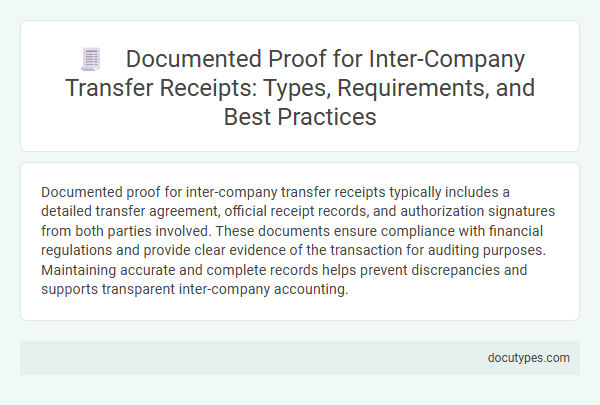Documented proof for inter-company transfer receipts typically includes a detailed transfer agreement, official receipt records, and authorization signatures from both parties involved. These documents ensure compliance with financial regulations and provide clear evidence of the transaction for auditing purposes. Maintaining accurate and complete records helps prevent discrepancies and supports transparent inter-company accounting.
Understanding Inter-Company Transfer Receipts
| Topic | Details |
|---|---|
| Definition of Inter-Company Transfer Receipts | Inter-company transfer receipts serve as documented evidence of transactions between different entities within the same corporate group. These receipts validate the movement of goods, services, or funds from one subsidiary or division to another. |
| Purpose | These receipts help maintain accurate financial records and ensure transparency in internal dealings. They support audit trails and compliance with accounting standards and tax regulations. |
| Key Components | Essential elements include the date of transfer, description of goods or services, quantity, transfer value, involved parties, and approval signatures. |
| Legal and Accounting Implications | Proper documentation functions as proof in case of audits or legal inquiries. It ensures proper consolidation of financial statements and prevents discrepancies in tax filings. |
| Your Role | You must retain these receipts carefully to support internal controls and financial integrity within the company. Organized documentation simplifies reconciliations and reporting. |
Importance of Documented Proof in Transfers
Documented proof for inter-company transfer receipts is essential for verifying the legitimacy of internal financial transactions. This documentation typically includes transfer receipts, invoices, or approval memos that record the details of the transaction.
Maintaining thorough documented proof ensures compliance with accounting standards and regulatory requirements. It helps prevent discrepancies during audits and supports accurate financial reporting. You can rely on these documents to validate transfers and enhance transparency between company divisions.
Types of Inter-Company Transfer Receipts
Inter-company transfer receipts serve as documented proof of goods or services exchanged between related entities within the same organization. Types of inter-company transfer receipts include physical goods transfer receipts, service transfer receipts, and internal billing invoices. Each type ensures accurate tracking and validation of transactions for accounting and auditing purposes.
Mandatory Information on Transfer Receipts
Documented proof for inter-company transfer receipts ensures transparency and compliance in internal transactions. Transfer receipts must include specific mandatory information to validate the transfer between entities within the same organization.
- Transfer Date - Specifies the exact date when the goods or services were transferred between the companies.
- Entity Details - Includes the names and contact information of both the transferring and receiving companies involved in the transaction.
- Description of Goods or Services - Details the items or services being transferred, including quantity, unit price, and total value.
Accurate mandatory information on transfer receipts is crucial for financial auditing and internal record-keeping.
Regulatory and Compliance Requirements
Documented proof for inter-company transfer receipts is essential to meet regulatory and compliance requirements. Your records must substantiate the transaction to ensure transparency and audit readiness.
- Invoice or Transfer Document - A formal invoice or transfer document must detail the goods or services exchanged between entities.
- Tax Compliance - The receipt should comply with local tax laws, including applicable VAT or GST identification and reporting.
- Audit Trail - Detailed records must be maintained to provide a clear audit trail, supporting regulatory inspections and internal controls.
Accepted Formats for Transfer Documentation
What is the documented proof required for inter-company transfer receipts? Inter-company transfer receipts must be supported by official documentation to ensure accuracy and traceability. Accepted formats include standardized transfer forms, invoices, and electronic transfer records compliant with accounting standards.
Common Errors in Receipt Documentation
Documented proof for inter-company transfer receipts is essential to verify the movement of goods or funds between related entities. Common errors in receipt documentation often include missing signatures and incorrect date entries.
These mistakes can lead to discrepancies during audits and affect financial reporting accuracy. Ensuring your receipts contain detailed descriptions and consistent information helps maintain transparent records and prevents compliance issues.
Best Practices for Document Retention
Documented proof for inter-company transfer receipts includes detailed transfer invoices, authorization signatures, and transaction reference numbers. Retaining digital and physical copies of these documents for a minimum of seven years ensures compliance with accounting standards and audit requirements. Consistent organization and secure storage of records facilitate efficient retrieval and reduce risks of discrepancies during financial reviews.
Technology Solutions for Managing Receipts
Documented proof for inter-company transfer receipts is essential for validating transactions between affiliated entities. Technology solutions such as automated receipt management systems streamline the collection, storage, and retrieval of these documents.
Cloud-based platforms enable secure digital archiving and real-time access to transfer receipts, ensuring compliance and audit readiness. Integration with enterprise resource planning (ERP) systems enhances accuracy and reduces manual errors in inter-company transaction documentation.
What Is the Documented Proof for Inter-Company Transfer Receipts? Infographic

